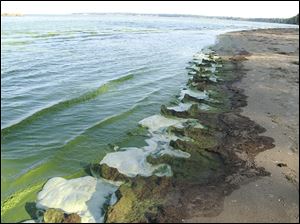
EDITORIAL
Lake at stake
Lake Erie’s future requires cooperation among government agencies, farmers, and residents
3/10/2014
Toxic algae lines the shores of Lake Erie at East Harbor State Park near Marblehead, Ohio.
Toxic algae will again likely take hold in western Lake Erie, but measures to minimize the runoff of manure, raw human waste, and chemical fertilizers must be taken immediately.
A new report, recommending 16 ways to improve water quality in Lake Erie, should spur federal and state officials to act. The International Joint Commission, a United States and Canadian agency charged with monitoring and controlling the Great Lakes, has determined that the lake is impaired by excess nutrients that feed the harmful algae.
Many of the recommendations are not new. Nevertheless, they serve as a timely reminder that a vigilant approach to reducing phosphorus levels could have a positive effect, even as soon as this summer. No action will lead to another record algae bloom, similar to the one in 2011 that disrupted the ecosystem, drinking water supplies, fisheries, recreation, tourism, and property values.
The 100-page report — “A Balanced Diet for Lake Erie: Reducing Phosphorus Loading and Harmful Algal Blooms” — exposes the lake’s decline in water quality over the past decade. Among recommendations to cut the overall phosphorus levels by 46 percent, and by 39 percent in the western part of the lake: improvements in municipal sewer systems, the restoration of wetlands around the lake, and a ban on applying fertilizers to frozen or snow-covered ground.
These are common-sense suggestions for a state that continues to push largely voluntary and incentive programs to minimize the impact on the farming industry. But more regulation should be mandatory in the form of commercial fertilizer application companies, which must follow guidelines to avoid runoff. Collaborative strategies — those without teeth — have failed to address lake pollution in recent years.
“Lake Erie is once again severely threatened,” the report reads. “The recent accelerating decline of this lake, manifested as impaired water quality, massive, summer-long algal blooms, hypoxia, and fish kills, has focused binational attention on the need for urgent actions to reduce external inputs of phosphorus.
“While Lake Erie’s health suffers from multiple stressors, the rising proportion of dissolved phosphorus is seen as the primary cause of this decline.”
Making matters worse, the U.S. Army Corps of Engineers is proposing open-lake dumping of sediment dredged from the Cuyahoga River in Cleveland, similar to the dredging of the Toledo Harbor. The plan would permit dumping the dredged sediment offshore, only three to five miles, near where four intake pipes supply drinking water to millions of area residents. Inaction to preserve Lake Erie’s quality — and even a foolish and risky assault on it — must cease.
Lake Erie’s future as a natural resource hangs in the balance. The report serves as an appropriate blueprint to encourage urgent action and cooperation between government agencies, farmers, and residents.